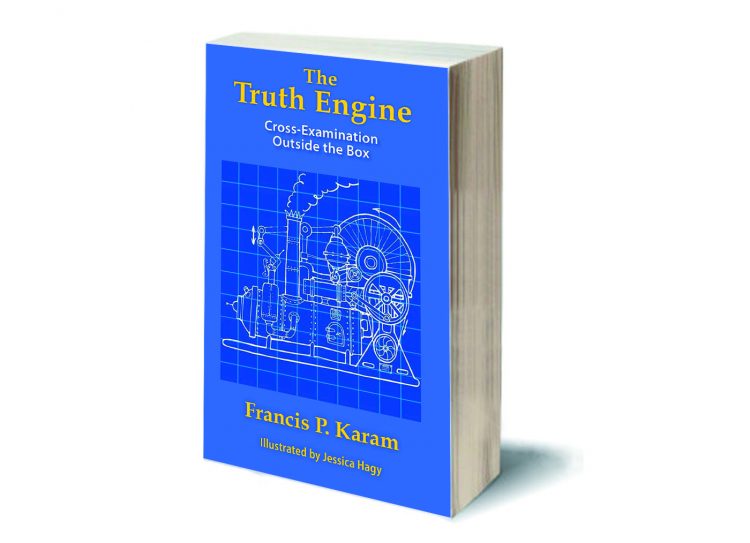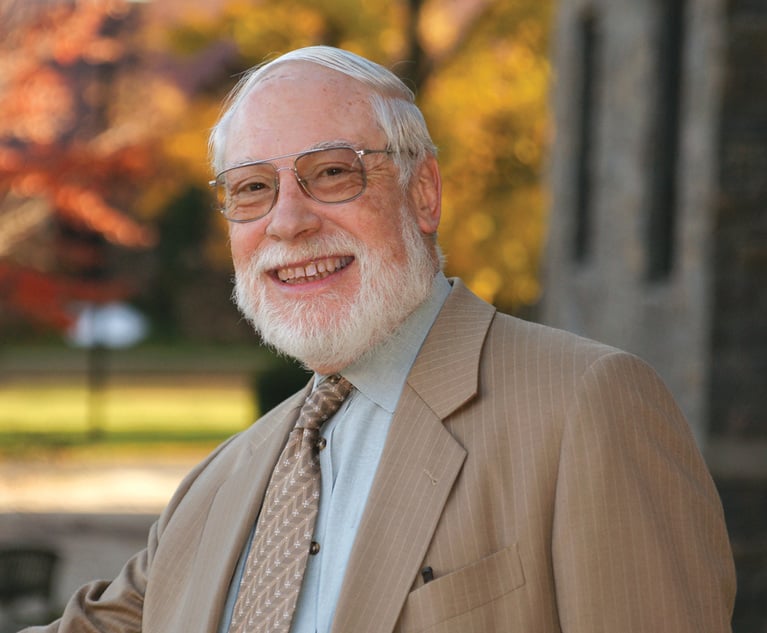Cross-Examination as Truth Engine
Cross-examiners can learn as much from Aristotle, Bruce Lee and Richard Feynman as they can from Irving Younger.
October 17, 2018 at 02:49 PM
6 minute read

The Truth Engine: Cross-Examination Outside the Box
By Francis P. Karam
Themistocles Books, New York, 255 pages, $60
Reviewed by Jeffrey Winn
In Charles Dickens' Bleak House, Dr. Allan Woodcourt famously said to the wrongly accused George Rouncewell: “But the mere truth won't do. You must have a lawyer.” Francis P. Karam's new book challenges the notion that seeking truth is not the objective of superior lawyering. In so doing, he posits that cross-examination is the primary “truth engine” that produces justice and winning results. Although this argument is hardly new, the author's fresh and seasoned analysis does produce a useful book that is, in his words, more about “how to be a cook” than it is a “book of recipes.”
Karam is an experienced litigator and trial attorney of over 35 years who began his career as a prosecutor before moving to private practice and handling both civil and criminal cases. The title of the book is borrowed from the distinguished scholar, John Henry Wigmore, who wrote over a century ago in his evidence treatise that cross-examination “is beyond any doubt the greatest legal engine ever invented for the discovery of truth…”
The author starts with the premise that, if cross-examination is the engine for the discovery of truth, “then the mechanics must be important.” The book is arranged in ten chapters, each of which poses one enduring question. Of the ten chapters, the best material appears in those dealing with truth and uncertainty, big facts, deep preparation, simplicity and storytelling.
Commenting that cross-examination is an underestimated thinking tool, the author observes that the book “is more about science, finance, storytelling, strategy, physical action and psychology, than it is about law or rules of evidence.” According to Karam, cross-examiners can learn as much from Aristotle, Bruce Lee and Richard Feynman as they can from Irving Younger. To illustrate his points, he has included over 75 Venn diagrams prepared by Jessica Hagy, a talented artist whose creations help explain difficult concepts in a basic visual format.
Entitled “Truth and Uncertainty,” the first chapter poses the question: “What truth is beneath the surface at the heart of the matter?” The author begins his inquiry by acknowledging that, while cross-examination can be useful in exposing falsehood, it does not always discover the truth. He illustrates this point by observing that Younger's famous “Ten Commandments of Cross Examination” (be brief; use plain words; use only leading questions; be prepared; listen; do not quarrel; avoid repetition; disallow witness explanation; limit questioning;and save for summation) makes no mention at all of the truth.
Arguing that integrity matters, Karam states that digging for the truth, understanding it and basing your case on it is the essence of a successful trial strategy and cross-examination. In so arguing, he advocates using cross-examination to ask questions which reveal the truth. In his view, an attorney who is “coming from a base of truth …will be a better person and a lawyer.”
In searching for the truths upon which the best cross-examinations are built, the author makes several useful suggestions. In analyzing a new case, he recommends “look[ing] for the truth at its center.” This involves identifying how your client is “biased, short sighted, exaggerating or misleading you.” It also involves recognizing that the truth should be pursued, even if it is “uncertain, hidden and unclear.”
According to Karam, adroit counsel is ever mindful that “the truth is unstable,” “facts will change,” “truth blindness” is a risk and truth is often missing from the first narrative devised in a case. He cautions that cross-examination should focus only on what counsel knows to be true or knows to be false. His main takeaway is that, even though “the whole truth in a case is difficult and cloudy,” there are “smaller truths that you can know, and the best cross-examinations build from these.”
The second chapter observes that facts are the basic building blocks of cross-examination, and a lawyer should reduce her case down to its smallest parts. Karam suggests beginning with the “simplest, most provable, [and] undisputed facts.” In drawing them out, he recommends using words that are “short, concrete and vivid.” He admonishes counsel to “delight in facts,” be “cautious about non-facts” and avoid “inferences and conclusions.”
Karam also warns that a lawyer should not create a theory simply because a certain legal conclusion will win a case. A masterful cross-examiner does not adopt a theory first and then search for the facts. Rather, she lets the theory come to her inductively from the facts she has learned in her investigation. In short, “the truth is the best strategy in any situation where the truth is knowable.”
The legendary UCLA basketball coach, John Wooden, was fond of saying: “Failing to prepare is preparing to fail.” Karam is a disciple of this principle. In the fourth chapter, he encourages “deep preparation,” in which the lawyer assembles her facts, works through the connections among them and constructs them into useful narratives. He also suggests that the lawyer engage her body and mind in different ways by practicing before a mirror or with someone playing the role of a witness. To get a “panoramic view” of her case, counsel should “[g]et up, walk around [and] think out loud.”
In the fifth chapter, Karam urges simplicity. Quoting Bruce Lee, he stresses that the height of cultivation is simplicity, “the ability to express the utmost with the minimum.” He notes that a simple and effective cross-examination is well planned, limited in topics and structured to the story. As a practical matter, he suggests that lawyers ask themselves the question: “What can I leave out of this case to make it easier for the judge and jury to see the truth?” Avoiding unnecessary ornamentation is important because a “false simplicity, charismatically presented, can defeat a complicated truth.”
The best part of the book addresses storytelling. Karam writes that a good story is the “creative demonstration of truth” and the mind's powerful way of comprehending it. Lawyers who build their cases as a story that tells the truth, rather than as an argument to be won, have the advantage because a good story arouses emotions connected to human experience, which help the jury to make sense of the events. “Story instinct,” rather than argument, permits the effective lawyer to see: (a) the strengths and flaws of the whole case; (b) where the case is going; and (c) what it is missing. To hone this instinct, Karam suggests that counsel write out her summation before the trial starts. In sum, this exercise will discipline the lawyer to focus on the “big picture” and “big facts” that compel the ending of her story.
Jeffrey Winn is a management liability attorney with Chubb Group, a global insurer, and serves as both a member of and the secretary to the executive committee of the New York City Bar Association.
This content has been archived. It is available through our partners, LexisNexis® and Bloomberg Law.
To view this content, please continue to their sites.
Not a Lexis Subscriber?
Subscribe Now
Not a Bloomberg Law Subscriber?
Subscribe Now
NOT FOR REPRINT
© 2025 ALM Global, LLC, All Rights Reserved. Request academic re-use from www.copyright.com. All other uses, submit a request to [email protected]. For more information visit Asset & Logo Licensing.
You Might Like
View All
The Public Is Best Served by an Ethics Commission That Is Not Dominated by the People It Oversees
4 minute read
The Crisis of Incarcerated Transgender People: A Call to Action for the Judiciary, Prosecutors, and Defense Counsel
5 minute readTrending Stories
- 1Gunderson Dettmer Opens Atlanta Office With 3 Partners From Morris Manning
- 2Decision of the Day: Court Holds Accident with Post Driver Was 'Bizarre Occurrence,' Dismisses Action Brought Under Labor Law §240
- 3Judge Recommends Disbarment for Attorney Who Plotted to Hack Judge's Email, Phone
- 4Two Wilkinson Stekloff Associates Among Victims of DC Plane Crash
- 5Two More Victims Alleged in New Sean Combs Sex Trafficking Indictment
Who Got The Work
J. Brugh Lower of Gibbons has entered an appearance for industrial equipment supplier Devco Corporation in a pending trademark infringement lawsuit. The suit, accusing the defendant of selling knock-off Graco products, was filed Dec. 18 in New Jersey District Court by Rivkin Radler on behalf of Graco Inc. and Graco Minnesota. The case, assigned to U.S. District Judge Zahid N. Quraishi, is 3:24-cv-11294, Graco Inc. et al v. Devco Corporation.
Who Got The Work
Rebecca Maller-Stein and Kent A. Yalowitz of Arnold & Porter Kaye Scholer have entered their appearances for Hanaco Venture Capital and its executives, Lior Prosor and David Frankel, in a pending securities lawsuit. The action, filed on Dec. 24 in New York Southern District Court by Zell, Aron & Co. on behalf of Goldeneye Advisors, accuses the defendants of negligently and fraudulently managing the plaintiff's $1 million investment. The case, assigned to U.S. District Judge Vernon S. Broderick, is 1:24-cv-09918, Goldeneye Advisors, LLC v. Hanaco Venture Capital, Ltd. et al.
Who Got The Work
Attorneys from A&O Shearman has stepped in as defense counsel for Toronto-Dominion Bank and other defendants in a pending securities class action. The suit, filed Dec. 11 in New York Southern District Court by Bleichmar Fonti & Auld, accuses the defendants of concealing the bank's 'pervasive' deficiencies in regards to its compliance with the Bank Secrecy Act and the quality of its anti-money laundering controls. The case, assigned to U.S. District Judge Arun Subramanian, is 1:24-cv-09445, Gonzalez v. The Toronto-Dominion Bank et al.
Who Got The Work
Crown Castle International, a Pennsylvania company providing shared communications infrastructure, has turned to Luke D. Wolf of Gordon Rees Scully Mansukhani to fend off a pending breach-of-contract lawsuit. The court action, filed Nov. 25 in Michigan Eastern District Court by Hooper Hathaway PC on behalf of The Town Residences LLC, accuses Crown Castle of failing to transfer approximately $30,000 in utility payments from T-Mobile in breach of a roof-top lease and assignment agreement. The case, assigned to U.S. District Judge Susan K. Declercq, is 2:24-cv-13131, The Town Residences LLC v. T-Mobile US, Inc. et al.
Who Got The Work
Wilfred P. Coronato and Daniel M. Schwartz of McCarter & English have stepped in as defense counsel to Electrolux Home Products Inc. in a pending product liability lawsuit. The court action, filed Nov. 26 in New York Eastern District Court by Poulos Lopiccolo PC and Nagel Rice LLP on behalf of David Stern, alleges that the defendant's refrigerators’ drawers and shelving repeatedly break and fall apart within months after purchase. The case, assigned to U.S. District Judge Joan M. Azrack, is 2:24-cv-08204, Stern v. Electrolux Home Products, Inc.
Featured Firms
Law Offices of Gary Martin Hays & Associates, P.C.
(470) 294-1674
Law Offices of Mark E. Salomone
(857) 444-6468
Smith & Hassler
(713) 739-1250








